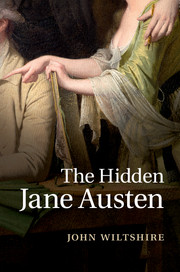Book contents
- Frontmatter
- Dedication
- Contents
- Preface
- Acknowledgements
- Introduction
- 1 Into the open with Catherine Morland
- 2 Elinor Dashwood and concealment
- 3 Elizabeth's memory and Mr Darcy's smile
- 4 The religion of Aunt Norris
- 5 The story of Fanny Price
- 6 Emma's overhearing
- 7 Anne Elliot and the ambient world
- Bibliography
- Notes
- Index
6 - Emma's overhearing
Published online by Cambridge University Press: 05 June 2014
- Frontmatter
- Dedication
- Contents
- Preface
- Acknowledgements
- Introduction
- 1 Into the open with Catherine Morland
- 2 Elinor Dashwood and concealment
- 3 Elizabeth's memory and Mr Darcy's smile
- 4 The religion of Aunt Norris
- 5 The story of Fanny Price
- 6 Emma's overhearing
- 7 Anne Elliot and the ambient world
- Bibliography
- Notes
- Index
Summary
A young lady arrives at her uncle's English country estate and finds the house ‘a picture made real’:
The large, low rooms, with brown ceilings and dusky corners, the deep embrasures and curious casements, the quiet light on dark, polished panels, the deep greenness outside, that seemed always peeping in, the sense of well-ordered privacy in the centre of a ‘property’ – a place where sounds were felicitously accidental, where the tread was muffled by the earth itself and in the thick mild air all friction dropped out of contact and all shrillness out of talk.
Readers might imagine Mansfield Park like this, given Fanny's own nostalgic idealisation, but this passage could hardly be by Jane Austen. For Austen's imagination is not pictorial or picturesque; the narrative rarely steps back and invites the reader to see rooms, or the way light falls within them, or to dwell on the atmosphere created by the physical surroundings her characters inhabit. The ‘dining-parlour’ of Northanger Abbey, she writes, ‘was a noble room, suitable in its dimensions to a much larger drawing-room than the one in common use, and fitted up in a style of luxury and expense which was almost lost on the unpractised eye of Catherine’, and certainly lost, one might feel, on the curious modern reader (NAii: 6, 170). Catherine's indifference to anything new in the way of interior appointments might be the excuse for equally vague characterisations of the various chambers that General Tilney shows her through, but the same reliance on her reader's knowing what rooms would be like is evident in all of Austen's novels. At Pemberley, the Gardiners and Elizabeth are shown into ‘a very pretty sitting-room, lately fitted up with greater elegance and lightness than the apartments below’ (P&Piii: 1, 276), which leads Elizabeth to reflect, as she walks towards a window, that Darcy, who has initiated this refurbishment, must be a kind brother. But no details are given, or perhaps needed: the true significance of this brotherly gesture is left to be inferred later. At the other end of the genteel social scale, Miss Bates and her mother ‘occupy the drawing room floor’ of a house belonging to ‘people in business’, further defined as ‘a very moderate sized apartment, which was every thing to them’ (E ii: 1, 166). That is all. Very little more information is added about the Bates' rooms in the course of the novel, although their confinement and the awkward stairs leading to them are certainly to become important factors, as it turns out, in the novel's action. Where rooms are concerned, Austen usually satisfies herself merely with indicative gestures. Everything is done in broad, simple strokes that principally focus on what one is tempted to call real-estate values. Windows, doors, tables, chairs and desks are only mentioned when the activities of characters require them. This paucity of visual information in the novels struck Lewes, who in his mid-nineteenth-century appreciation wrote that ‘So entirely dramatic, and so little descriptive, is the genius of Miss Austen, that she seems to rely upon what her people say and do for the whole effect they are to produce on our imaginations.’ And moreover that ‘the absence of all sense of outward world – either scenery or personal appearance – is more remarkable in her than in any writer we remember’.
- Type
- Chapter
- Information
- The Hidden Jane Austen , pp. 123 - 146Publisher: Cambridge University PressPrint publication year: 2014



